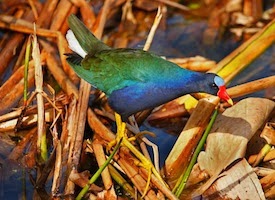The focus of todays posts are the two major "blocks" of Louisiana waterfowl species hunted in the fall months. The spreadsheet for Migratory and Waterfowl Game Hunting Seasons can be found on the LDWF Website here:
So lets break down "block" number one... The bulk of the species harvested occurs from September 14th to the 29th. During this two week span waterfowl hunters throughout Louisiana's three designated hunting zones can harvest Rails and Gallinules. These two species belong to the same order and family. As a student devoted to the study and conservation of wild game species I fully understand that the nomenclature associated with the animals can get way too scientific. In the interest of my sanity, and the understanding of you, the reader, I'll try to keep things as uniform as possible in regard to the jargon used.
Order: Gruiformes
Family: Rallidae
Rails are a diverse species of waterfowl. These birds have many sub-species throughout their family tree due to the environment they live in. As I mentioned in an earlier post, animals that live in the Delta thrive in one of Earth's most diverse and dynamic biomes. Because of this, the species has many different relatives each with its own adaptations unique to the environment they live in. (This fact is reflected in Charles Darwin's study of Finches in the Galapagos). The Rails that are legal to harvest in the Delta include King, Clapper, Sora and Virginia.
King: The King is a large Rail that thrives in freshwater marshes. While some communities fly north during the summer to breed in the Mid-Western United States, others can be found year-round along the Gulf Coast from Texas, throughout the bayou, into the Florida panhandle and down it's Atlantic coast line.
- Medium-size
- Compact body
- Short tail
- Long, downward sloping bill
- Reddish chest, neck and back
- Black and white stripes along flanks
Clapper: The Clapper is another relatively large rail that dwells in saltwater marshes from Massachusetts to South America. Their southern-bound migration brings their flight path directly across the Delta where they are able to seek refuge among the thousands of coastal marshes across Louisiana.
- Medium-size waterfowl
- Chicken-like
- Compact body
- Short tail
- Long legs
- Long, downward sloping bill
Sora: The Sora is a small bird that makes its home in the cattails of freshwater marshes. This bird is one of the most common and widely distributed Rail in North America. While this bird is extremely vocal, its small stature and tendency to walk along the bottom of the marsh makes it extremely difficult to hunt.
- Small size
- Triangular body shape, deep rear end
- Slaty gray body
- Short, yellow bill
- Short tail, white underneath
- Black face and bib
Virginia: This is probably my favorite Rail, not only because it shares the name of my home state, but because of its beautiful adaptations that make it bane of the predators who hunt it. This small waterbird lives among the freshwater marshes of the northern U.S. and southern Canada. However, during the winter months it migrates south to the warmer waters of the Gulf Coast. A laterally compressed body, long toe structure and flexible vertebrae allows this organism to sit flush with marsh undergrowth making it extremely difficult to hunt. Undoubtedly, the Virginia is the most difficult Rail to harvest.
- Small size
- Compact body
- Short tail
- Rufous (reddish-brown) throat and breast
- Gray cheeks
- Long, slightly curved, red bill
Gallinules
Order: Gruifromes
Family: Rallidae
Purple Gallinule: This waterbird, of the Gulf Coast and Tropical North America, is the personification of beauty. Its extremely long toes allow the bird to walk across marsh vegetation without sinking. Like the Sora and Virginia Rail, the Purple Gallinule eludes predators by bedding in thick vegetation.
- Dark purple head, neck and underside
- Green back
- Triangular, red bill with a yellow tip
- Light blue forehead
- Yellow legs
Common Gallinule: Claiming the title as the most widely distributed member of the Rail family, the Common Gallinule lives in marshes and ponds from Canada to Chile. The waterbird can even be found from northern Europe to southern Africa, with large communities thriving across Asia and the Pacific. This territorial bird makes its presence known throughout the world's ecosystems, boldly strutting across vegetation, calling to others, marking its territory.
- Dark, with a white flank stripe
- Red bill and forehead
- Swims like a duck
- Triangular bill
- White stripe on sides of undertail
As you can see hunters in Louisiana have a wide variety of waterbird to harvest in the season's early weeks. All of the information on Rails and Gallinules above was pulled from the Cornell Lab of Ornithology.
http://www.allaboutbirds.org/guide/browse_tax/49/
Hope y'all enjoyed. See you shortly.
Good Hunting,
Gersh






No comments:
Post a Comment